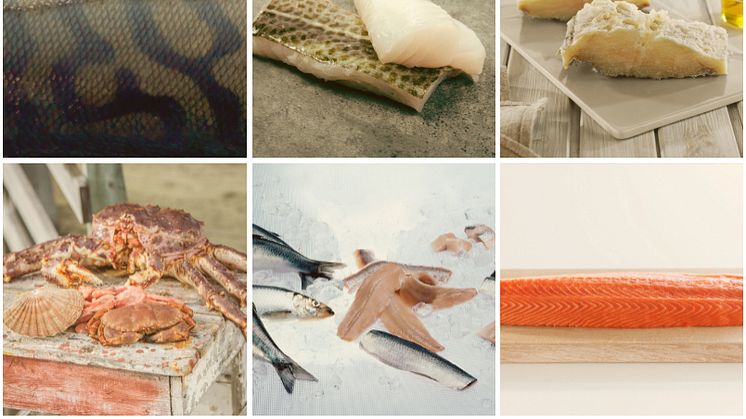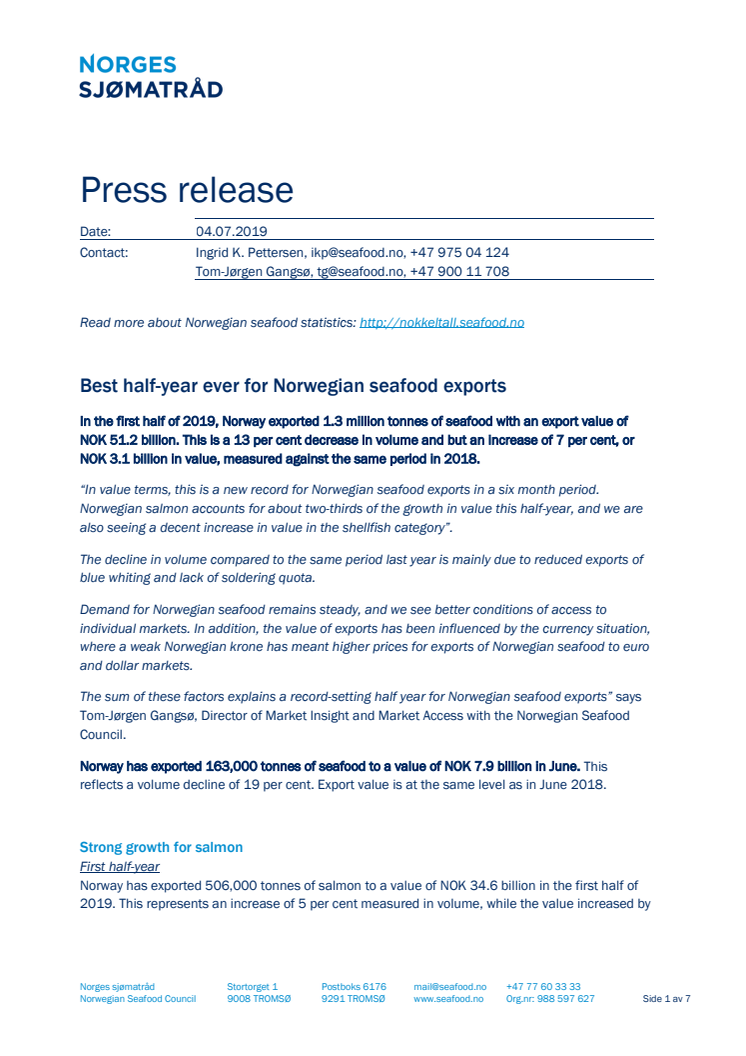
Press release -
Best half-year ever for Norwegian seafood exports
In the first half of 2019, Norway exported 1.3 million tonnes of seafood with an export value of NOK 51.2 billion. This is a 13 per cent decrease in volume and but an increase of 7 per cent, or NOK 3.1 billion in value, measured against the same period in 2018.
“In value terms, this is a new record for Norwegian seafood exports in a six month period. Norwegian salmon accounts for about two-thirds of the growth in value this half-year, and we are also seeing a decent increase in value in the shellfish category”.
The decline in volume compared to the same period last year is mainly due to reduced exports of blue whiting and lack of soldering quota.
Demand for Norwegian seafood remains steady, and we see better conditions of access to individual markets. In addition, the value of exports has been influenced by the currency situation, where a weak Norwegian krone has meant higher prices for exports of Norwegian seafood to euro and dollar markets.
The sum of these factors explains a record-setting half year for Norwegian seafood exports” says Tom-Jørgen Gangsø, Director of Market Insight and Market Access with the Norwegian Seafood Council.
Norway has exported 163,000 tonnes of seafood to a value of NOK 7.9 billion in June. This reflects a volume decline of 19 per cent. Export value is at the same level as in June 2018.
Strong growth for salmon
First half-year
Norway has exported 506,000 tonnes of salmon to a value of NOK 34.6 billion in the first half of 2019. This represents an increase of 5 per cent measured in volume, while the value increased by NOK 2.1 billion or 6 per cent compared with the first half of 2018. Poland, France and Denmark were the largest recipients of salmon from Norway in the first half of 2019.
«We have seen stronger production outputs of salmon in the first half of the year than was expected at the beginning of the year. At the same time, we have experienced a growth in demand, especially from the EU and Asia.
The growth in demand, together with a weak krone, explains why we have also experienced price inflation, while volumes have increased” says Tom-Jørgen Gangsø, Director of Market Insight and Market Access.
Salmon in China
So far this year, we have seen growth in both the value and volume of fresh salmon exports to China. Overall, 12,130 tonnes of fresh salmon from Norway were exported to China during the first six months of the year. This figure is already more than was exported throughout 2018, which saw 12,000 tonnes of Norwegian salmon exported to China.
“We are now seeing considerably more Norwegian salmon making its way to China. These increased exports are mainly due to improving market access in the form of more efficient trading, as well as new manufacturers gaining access to the market. On average, about 200 tonnes more Norwegian salmon are entering China each week than during the same period in 2018.
If present trends continue, we can project that Norway will export more than 20,000 tonnes of salmon to China during 2019. Norway continues to strengthen its position and take an increasing share of the rising demand in the market” says Victoria Braathen, with the trade mission of the Norwegian Seafood Council in China.
In June, Norway exported 82,300 tonnes of salmon worth NOK 5.7 billion. This is a decrease in volume of 3 per cent, while the export value increased by 2 per cent or NOK 133 million compared to the first half of last year. The average price for fresh whole salmon increased from NOK 61.77 per kg to NOK 64.20 per kg.
Strong growth in export value of trout
First half-year
Norway has exported 24,700 tonnes of trout worth NOK 1.7 billion in the first half of 2019. The volume of exports has increased by 19 per cent, while the value increased by NOK 276 million or 20 per cent compared with the first half of last year.
"In addition to volume growth, there has also been a shift towards exports of fillet of trout in the first half of 2019. We see growth in the US market, where Norwegian trout is gaining ground, as a result of increased accessibility in both the retail trade and in the restaurant market.
The volume increase has led to somewhat lower prices for both fresh and frozen whole fish, but at the same time we see that fillet prices have increased. Some of this can probably be explained by the fact that the Norwegian kroner is particularly weak against the dollar,” says Tom-Jørgen Gangsø.
In June, Norway exported 5,600 tonnes of trout to a value of NOK 331 million. This represents a volume increase of 76 per cent, and a value increase of NOK 110 million or 50 per cent. The US, Belarus and Thailand were our largest markets for Norwegian trout in the first half of 2019.
Reduced exports of fresh cod – strong half-year for frozen cod exports
First half-year - fresh cod
Norway has exported 40,200 tonnes of fresh cod with a value of NOK 1.7 billion during the first half of 2019. This is a decrease in volume of 21 per cent, and a fall of NOK 123 million or 7 per cent in export value.
“The winter has been characterized by stable and high first-hand prices for cod, partly due to lower quotas and high competition for the raw material. The reduced quotas have also resulted in lower export volumes for fresh, whole cod. The exception here this winter is the export of fresh, whole screi where we have seen record highs in both volume and prices”, says Ingrid K. Pettersen, Seafood Analyst with the Norwegian Seafood Council.
In June, 2,100 tonnes of fresh cod were exported with a value of NOK 96 million. This is a decrease in volume of 36 per cent, while export value fell by NOK 25 million or 20 per cent. Denmark, Poland and the Netherlands were the largest recipients of fresh cod in the first half of 2019.
First half-year - frozen cod
Norway has exported 40,100 tonnes of frozen cod worth NOK 1.7 billion in the first half of 2019. This is an increase of 3 per cent, while the value increased by NOK 293 million or 21 per cent from the same period last year. China, the UK and Lithuania were the largest recipients of frozen cod in the first half of 2019.
"The strong growth of frozen cod to the UK so far in 2019 is mainly due to two things: strong competition for the raw material, lower quotas and higher price growth, and the fact that UK grocery chains want to secure enough raw material due to the uncertainty around Brexit. We have also received feedback from UK importers that consumer demand for cod remains strong” says Hans Frode Kielland Asmyhr, with the Norwegian Seafood Council's UK Trade Mission.
In June, Norway exported 3,600 tonnes of frozen cod worth NOK 166 million. This is a decrease in volume of 41 per cent, while the value of exports fell by NOK 78 million or 32 per cent.
Stable half-year for Norwegian clipfish exports – but a significant reduction for saltfish
First half-year - clipfish
Norway has exported 41,700 tonnes of clipfish to a value of NOK 2 billion during the first half of the year. This is a decrease in volume of 2 per cent, while the value increased by NOK 23 million or 1 per cent. Portugal, Brazil and the Dominican Republic were the main markets for clipfish in the first half.
"Saithe clipfish especially is pushing up the value, with both increased volumes and prices. We have seen the biggest growth in Brazil, which can be explained by an early Easter and improved market access. In addition, there has been significant growth in export value to Portugal, driven by higher prices,” says Ingrid K. Pettersen
In June, Norway exported 5,300 tonnes of clipfish to a value of NOK 285 million. This is a reduction of 23 per cent in volume and a fall in value of NOK 49 million or 15 per cent.
First half-year – salted fish
Norway has exported 17,000 tonnes of salted fish to a value of NOK 942 million in the first half of 2019. This is a decrease in volume of 21 per cent, and a fall in value of NOK 107 million or 10 per cent. Portugal, Spain and Greece were our main saltfish markets in the first half.
“The high price of cod saltfish has resulted in some Portuguese clipfish producers hesitating to buy Norwegian saltfish in anticipation of lower prices. This has probably contributed to the uncertainty of Norwegian producers of salted fish, which has led to lower production in Norway”, says Johnny Thomassen, with the Norwegian Seafood Council's Trade Mission in Portugal.
"At the same time, we see that exports of Icelandic saltfish to Portugal have increased, but the increase from Iceland has not been large enough to compensate for the reduction from Norway," continues Thomassen.
"Our data sources do not provide a clear picture of the trend in consumption, but we have some signals that there is significant demand, but little clipfish available in the Portuguese market," says Johnny Thomassen.
In June, Norway exported 2 800 tonnes of salted fish to a value of NOK 150 million. This is a decrease in volume of 18 per cent, while export value fell by NOK 11 million or 7 per cent.
Growth in export value of dried fish
Norway has exported 1,100 tonnes of codfish to a value of NOK 239 million in the first half of 2019. This is a decrease of 11 per cent, while export value increased by NOK 16 million or 7 per cent. Italy, the USA, and Croatia were our main markets for cod stockfish in the first half.
"Exports of dried fish during the first half of the year have been characterized by high prices and lower volumes, as a result of lower production of stockfish in 2018. Now most of last year's production will be exported, and there is good momentum in the market ahead of next season", says Ingrid K. Pettersen.
"Exports of stockfish to Nigeria this year have been characterized by very little fish in stock at the end of 2018, so there has been little available for export. Of this year's production, which is soon ready for delivery, much has already been sold at record-setting prices," says Trond Kostveit, with the Norwegian Seafood Council's Trade Mission for Western and Central Africa.
In June, Norway exported 56 tonnes of cod dried fish to a value of NOK 12 million. This is a decrease in volume of 63 per cent, while the value fell by NOK 14 million or 54 per cent.
Moderate export value increase for herring
First half-year
Norway has exported 147,000 tonnes of herring to a value of NOK 1.3 billion in the first half of 2019. This volume is at the same level as in 2018, while the value of herring exports has increased by NOK 35 million or 3 per cent. Poland, Lithuania and Egypt were the main markets for Norwegian herring in the first half of 2019.
"The first six months have seen an increase in exports of frozen whole herring, while we see a decrease in exports of fillets. The reason for the reduction in fillet exports is reduced demand from Germany after they bought a lot of herring last fall. Although the volumes of frozen herring have increased, prices have remained stable. Expectations of lower supply can help to explain this,” says Tom-Jørgen Gangsø.
In June, Norway exported 19,000 tonnes of herring to a value of NOK 229 million. This is a decrease in volume of 43 per cent, while the value of exports fell by NOK 48 million or 17 per cent.
Strongest half-year for mackerel
First half-year
Norway has exported 81,000 tonnes of mackerel to a value of NOK 1.4 billion in the first half of 2019. This is an increase of 5 per cent, while the value increased by NOK 384 million or 38 per cent. China, South Korea and Japan were the largest markets for Norwegian mackerel in the first half.
“Despite reduced quotas, we see growth in mackerel exports from Norway. The fear of the consequences around Brexit has meant that British fishermen have started earlier this year, and this has resulted in increased landings in Norway. Expectations of low supply of mackerel have given rise to higher prices and so we have seen the strongest mackerel half-year ever,” says Tom-Jørgen.
Mackerel in Japan and South Korea
"Increased attention to health and nutrition, sustainability and the origin of seafood are trends that are evident in both Japan and South Korea. This is something that the retail chains have been concerned about and we see that this is starting to resonate with consumers. In addition, customers want convenience, which has led to large increases in demand for and supply of different types of mackerel products. The market is quite stratified and consumers can choose raw, fried, salted, boxed and miso-marinated, to name a few of the varieties on offer.
In recent years, the mackerel has moved from traditional forms to becoming popular for "ready to heat" or "ready to eat", especially among young people. This also means that people want more ready-made mackerel products than the ranges we offer today, and consumption is changing somewhat in South Korea as it has increases in Japan,” according to Gunvar L. Wie, with the Norwegian Seafood Council's Japan and South Korea Trade Mission.
In June, Norway exported mackerel 8,800 tonnes of mackerel to a value of NOK 156 million. This is an increase in volume of 26 per cent, while export value increased by NOK 59 million or 61 per cent.
Strong rise in export value of King Crab First half-yearNorway has exported 844 tonnes of king crab to a value of NOK 264 million in the first half of 2019. This is an increase of 24 per cent, while the value increased by NOK 69 million or 35 per cent.
King crab in South Korea
“Fish and shellfish from Norway make up an increasingly large part of the seafood intake in South Korea. Demand for Norwegian seafood is increasing, which is also positive for the Norwegian king crab's increasing market share.
It is estimated that live king crab in South Korea accounts for over 90 percent of the total volume. There are many seafood-specialized restaurants with seafood storage, and estimate that most of the Norwegian king crab that is consumed in Korea is sold in the restaurant market,” says Gunvar L. Wie, with the Norwegian Seafood Council.
In June, Norway exported 124 tonnes of king crab to a value of NOK 39 million. This is an increase in volume of 10 per cent, while the value increased by NOK 5 million or 13 per cent. South Korea, the United States and the Netherlands were the largest recipients of Norwegian king crab in the first half of 2019.
Prawns exports also growing
First half-year
7,500 tonnes of prawns were exported to a value of NOK 552 million in the first half of 2019. This represents an increase in volume of 65 per cent, and an increase in value of NOK 178 million or 49 per cent in the first half of 2019. The largest recipients of Norwegian prawns during the first half of the year were Sweden, the UK and Finland.
"The prawn product that has had the largest volume growth is raw, frozen prawns packaged as raw material for production in other markets, especially Iceland - which is almost entirely dependent on imports for its production. This has the effect of depressing the average price for exported prawns.
At the same time, we have also seen growth in volume and price in our most important consumer markets. We have seen a large increase in export volume to the UK, which, as we have also seen for frozen cod, is partly explained by the ongoing uncertainty surrounding Brexit. At the same time, we also see promising development in markets such as Sweden and Finland. It appears that prawns are now a relatively fixed part of the fishermen's portfolio, and helps to ensure stability in the price of raw material,” says Ingrid K. Pettersen.
In June, Norway exported 1,200 tonnes of prawns to a value of NOK 92 million. This is an increase in volume of 35 per cent, while the value increased by NOK 22 million or 32 per cent compared with June last year.
Topics
Categories
The Norwegian Seafood Council works with the Norwegian fisheries and aquaculture industries to develop markets for Norwegian seafood through local market intelligence, market development and reputational risk management. The Seafood Council is headquartered in Tromsø and maintains local representatives in twelve of Norway's most important international markets. The Norwegian seafood industry finances the activities of the Norwegian Seafood Council via a tariff on all Norwegian seafood exports.
The Norwegian Seafood Council is a public company owned by the Ministry of Trade, Industry and Fisheries.


